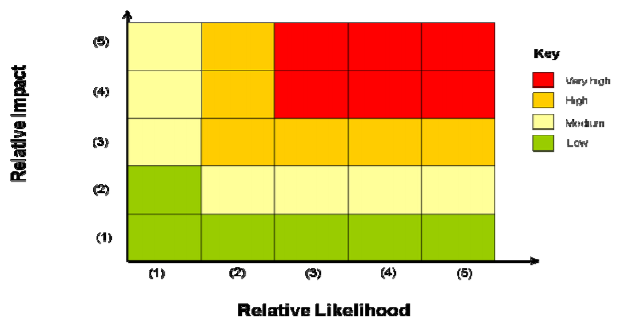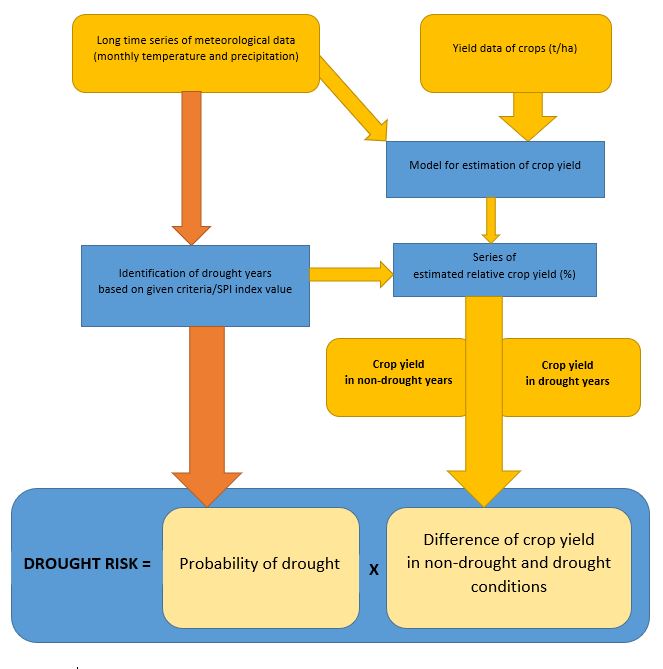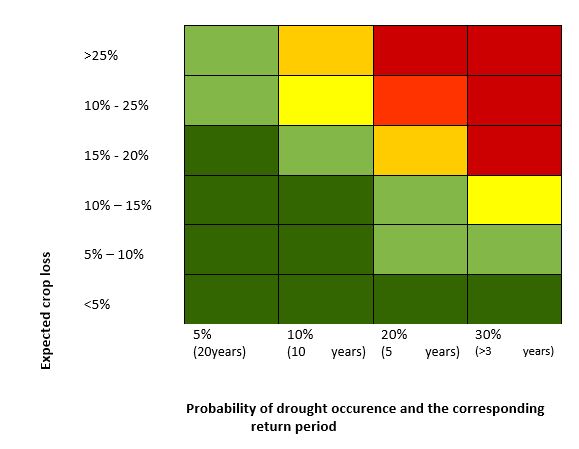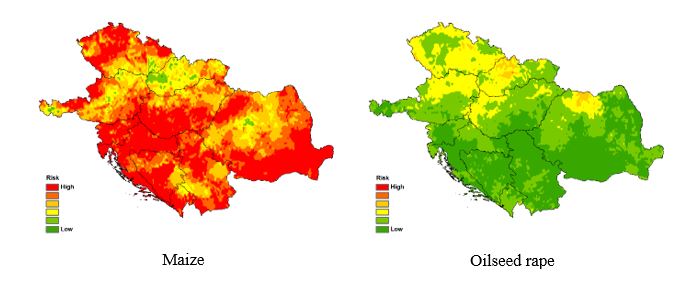DriDanube - Danube Drought Risk Assessment
08-04-2019
Droughts and their impacts are occurring with increasing frequency and magnitude across the Danube region. Their costs are underestimated, particularly in countries where assessment capacities and drought management systems are the weakest. The risk assessment and mapping of the drought risk are key parts of the successful drought risk management process.
Risk assessments when carried out at national level are crucial for enhancing disaster prevention and preparedness activities and contribute significantly to planning and capacity building.
What is RISK?
According to the EU Civil Protection mechanism:
RISK = probability of occurrence X degree of impact (cost/consequences)

Picture 1: Example of Risk matrix
Source: https://ec.europa.eu/echo/files/about/COMM_PDF_SEC_2010_1626_F_staff_working_document_en.pdf
Drought Risk
The main aim of this activity in the DriDanube project is to improve coherence among the risk assessments undertaken in all involved countries and to make one drought risk assessment comparable among countries. This will lead to a greater transparency and it will facilitate co-operation in efforts to prevent and mitigate shared drought risks, such as cross-border drought risks.
Methodology
Methodology developed for the purpose of preparation of regional risk maps for selected crops is following conceptual framework set in the European Commission’s Risk Assessment and Mapping Guidelines for Disaster Management. To say it simply, Drought risk is calculated from probability of occurrence and degree of impacts.
However, there were some challenges during the preparation of the methodology. The main one - how to get reliable hazard impact data? The reality is that unfortunately reliable meteorological drought loss values or hazard impact data do not exist, at least not on transnational scale. For solving this problem we used the crop yield values and some drought indices (e.g. SPI) for drought identification. Crop yield values from different countries and different time periods were then used in a regression model in order to obtain crop loss data with the same spatial and temporal dimensions as meteorological data.
The final result of this methodology can be summarized as:
DROUGHT RISK = probability of drought X difference of crop yield in non-drought and drought conditions
Calculation of Drought Risk
First step is to extrapolate crop yield over time period and locations of available meteorological data (at least temperature and precipitation is needed). This step can be avoided if crop yield data with sufficient coverage is already available.
Second step is to separate years of available data to two sets – years with drought occurrence and years without drought occurrence. Application of Standardized Precipitation Index (SPI) is already available within the RED risk calculation software (software developed within DriDanube). Other indices or criteria for drought identification can be applied, however information on probability of occurrence has to be provided along with index values and thresholds.
Third and final step is calculation of risk – composition of loss function, which is based on difference of expected crop yield values in non-drought and drought years and on probability of drought occurrence.

Picture 2: Flow chart of drought risk assessment procedure
Mapping drought risk
The drought risk maps provide information about spatial distribution of those areas where meteorological drought occurred often as hazard and there were significant impacts on crop yield in the Danube region. Drought risk maps are available for maize, wheat, barley and rape on different drought occurrence probability levels (5, 10, 20, 30%).
The drought risk assessment method is a quantitative approach and the algorithm with the RED risk calculation software was newly developed in the frame of DriDanube project. It can be used to recognize which crops are sensitive for deficit of rain in the region and on which areas a significant drought hazard and/or considerable crop losses are expected based on the analysis of long term period (1961-2010) in the past.
The map color codes were defined with help of a risk matrix (Picture 3). The matrix depicts probability of drought occurrence in horizontal axis and expected crop loss in vertical axis.

Picture 3: Matrix used for color codes of drought risk maps for all the crops (degree of risk – Green = low; yellow = moderate; red = high)
For better understanding:
- If location is colored in dark red color on 20% drought probability level map, we can expect more drought events in this area or we can expect higher crop loss due to droughts in this area. This situation is interpreted as high risk.
- The red color is representing the higher risk area: where drought occurred often as hazard in a long-term period (1961-2010) and/or the drought reduced crop yield significantly.
- The green color representing the lower risk area: where drought events occurred rarely in the past and/or we could not find considerable negative impacts on crop yield due to drought which identified SPI index.

Picture 4: Drought risk maps for maize and oilseed rape on 20% probability of drought occurrence in the DriDanube region
